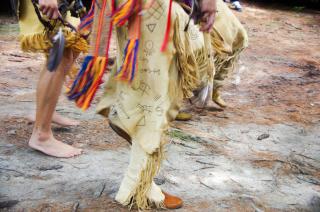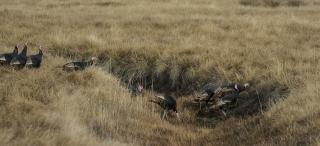A Thanksgrieving Reflection
I want to tell you about my bicycle. The frame is a sparkly kind of blue and it has pink handlebar tape. And guess what color the wheels are? Lime green!
I love my bicycle. Now suppose this was your bicycle. And suppose one day you biked to school and totally forgot to lock your bike when you got there. And then, when it was time to leave, you went outside to get on your bike and… No bike! It was stolen. Bah!
Okay, so you had to get a ride home and figure out how to get to school from now on. Then, in art class the next week, someone brings in a sculpture of a turkey they’ve made. It has a sparkly blue body made of pieces of metal, a big round tail with a lime green circle around it, pink feet curving underneath it, … and a bicycle seat for a head. In fact, the whole thing is made from a bicycle. And you realize it’s your bicycle. Your former, stolen, cut-up-into-pieces bicycle.
But before you can say anything, your classmates are cheering and the principal decides to make the sculpture the new school mascot. And she institutes a new school holiday called Turkey Creativity Day, and every year from now on, everybody gets to spend a whole day making art.
Now, nothing against creativity but… this is kind of a nightmare.
I’m telling you this story because it’s basically the story of Thanksgiving — except Thanksgiving is worse. I’ve started writing and saying “Thanksgrieving” instead of Thanksgiving, because in popular culture, we’ve come to see Thanksgiving as a commemoration of a friendly feast shared by Native Americans and European settlers… but this is like Turkey Creativity Day: a really nice idea that covers up theft and treachery.
Although both Native American and Europeans had feasts expressing gratitude during harvest time, the Europeans who arrived on this continent were incredibly destructive to Native American communities. The Wampanoag man often celebrated as a friend of the pilgrims, Tisquantum, spoke English because traders had enslaved him and forcibly taken him to England. When he finally escaped and made his way back home, his community had all died from smallpox his captors had left behind. He was friendly to the pilgrims who moved into the land of his people because none of his own people were left. He was able to find work with the pilgrims as a translator and helped them negotiate treaties.
But as we know, treaties between European settlers and the indigenous residents of America have not been honored by the new arrivals. And although there’s some evidence of a shared meal between Europeans and Wampanoag people in 1621, the holiday may actually have started a few decades later, in May 1637, when English and Dutch mercenaries attacked the Pequot Tribe. They killed over 700 people, and the next day the governor of the Massachusetts Bay Colony declared a day of Thanksgiving in celebration.
Since then, various governors and presidents called for days of Thanksgiving to commemorate various events, but it didn’t get formalized into an annual holiday until Abraham Lincoln chose a Thursday in November in 1863 to celebrate Civil War victories.
Now, nothing against gratitude, but the legacy of Thanksgiving is a nightmare. The 400-year-old story we’ve heard about harmony between people of different backgrounds just isn’t true.
The United American Indians of New England have commemorated a National Day of Mourning every fourth Thursday in November since 1970. They write,
“Thanksgiving day is a reminder of the genocide of millions of Native people, the theft of Native lands, and the relentless assault on Native culture. Participants in National Day of Mourning honor Native ancestors and the struggles of Native peoples to survive today. It is a day of remembrance and spiritual connection as well as a protest of the racism and oppression which Native Americans continue to experience.”
It may be uncomfortable to hear this as you prepare for your Thanksgiving festivities. We celebrate Thanksgiving because gratitude is essential to human life. But grief is essential for healing our history of violence. It’s really hard to be thankful and sorrowful at the same time. But this is life: sometimes, joy and sorrow come together.
References and Resources
- Maya Salam, “Most Everything You Learned About Thanksgiving Is Wrong,” New York Times, Nov. 21, 2017.
- Lindsay McVay, “Everyone’s history matters: The Wampanoag Indian Thanksgiving story deserves to be known,” Smithsonian National Museum of the American Indian blog, Nov. 22, 2017.
- Maxine Phillips, “Rethinking Thanksgiving,” Morningside Center for Teaching Social Responsibility, November 14, 2016,
- Adam Ericksen, “The Truth About Thanksgiving: Why You Should Celebrate,” Sojourners Magazine, Nov. 19, 2012,
- Roxanne Dunbar-Ortiz, “Yes, Native Americans Were the Victims of Genocide,” Columbian College of Arts and Sciences History News Network blog, May 12, 2016,
- United American Indians of New England
| Date added | |
|---|---|
| Tagged as |

